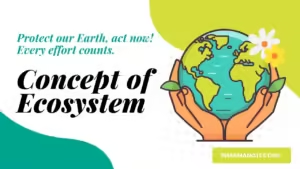Concept of Ecosystem

Intended Learning Outcomes
At the end of this Lecture, students will be able to
• Explain the concept of an ecosystem
• Understand ecosystems
• Discuss ecosystem degradation
• Describe resource utilization
Concept of Ecosystem
• An ‘Ecosystem’ is a region with a specific and recognizable landscape form such as forest, grassland, desert, wetland or coastal area
• The nature of the ecosystem is based on its geographical features such as hills, mountains, plains, rivers, lakes, coastal areas, or islands
• It is also controlled by climatic conditions such as the amount of sunlight, the temperature, and the rainfall in the region
• The geographical, climatic, and soil characteristics form its non-living (abiotic) component
• The living part of the ecosystem is referred to as its biotic component
• Ecosystems are divided into terrestrial or land-based ecosystems and aquatic ecosystems in water
• Ecosystems have been formed on land and in the sea by evolution that has created species to live together in a specific region
• Thus ecosystems have both non-living and living components
• Some ecosystems are fairly robust and are less affected by a certain level of human disturbance. Others are highly fragile and are quickly destroyed by human activities
• Mountain ecosystems are extremely fragile as degradation of forest cover leads to severe erosion of soil and changes in river courses
• Island ecosystems are easily affected by any form of human activity which can lead to the rapid extinction of several of their unique species of plants and animals
• Evergreen forests and coral reefs are also examples of species rich fragile ecosystems that must be protected against a variety of human activities that lead to their degradation
• River and wetland ecosystems can be seriously affected by pollution and changes in surrounding land use
Understanding ecosystems
• Natural ecosystems include forests, grasslands, deserts, and aquatic ecosystems such as ponds, rivers, lakes, and sea
• Man-modified ecosystems include agricultural land and urban or industrial land use patterns
• Each ecosystem has a set of common features that can be observed in the field:
• ‘What does the ecosystem look like?’ One should be able to describe specific features of the different ecosystems in one’s surroundings
• What is its structure? Is it a forest, a grassland, a water body, an agricultural area, a grazing area, an urban area, an industrial area, etc.?
• What you should see are its different characteristics. A forest has layers from the ground to the canopy. A pond has different types of vegetation from the periphery to its center. The vegetation on a mountain changes from its base to its summit
• What is the composition of its plant and animal species? List the well-known plants and animals you can see. There are so many that they cannot be easily counted
• ‘How does the ecosystem work’? The ecosystem functions through several biogeochemical cycles and energy transfer mechanisms
Ecosystem degradation
• Ecosystems are the basis of life itself
• Natural ecosystems in the wilderness provide a variety of products and are regions in which many vital ecological processes are present, without which human civilization would not be able to exist
• Ecosystems are however frequently disrupted by human actions which lead to the extinction of species of plants and animals that can live only in the different natural ecosystems
• Some species if eliminated seriously affect the ecosystem. These are called ‘keystone’ species
• Extinction occurs due to changes in land use. Forests are deforested for timber, wetlands are drained to create more agricultural land, and semi-arid grasslands that are used as pastures are changed into irrigated fields
• Pollution from industry and waste from urban settings can also lead to extinction of several species
• The reason for the depletion of natural resources is twofold – our rapidly exploding population that needs to sustain itself on resources and the growth of affluent societies, which consume and waste a very large proportion of resources and energy
• If one thinks before wasting resources such as water, reusing, and recycling paper, and using fewer non-degradable plastic, ultimately this can have positive implications on the integrity of our natural resource base and conserve the resources that nature provides
• Every region of our earth has different ecosystems based on its climatic conditions and geographical feature
Resource utilisation
• Most traditional societies used their environment sustainably
• In recent times the proportion of ‘rich’ people in affluent societies, has grown rapidly
• Inequality thus became a serious problem
• Whereas in the past many resources such as timber and fuel wood from the forest were extracted sustainably, this pattern has drastically changed during the last century
• Economically better-off sections began to use greater amounts of forest products, while those people who lived in the forest became increasingly poor
• Similarly the building of large irrigation projects led to wealth in those areas that had canals, while those who had to remain dependent on a constant supply of water from the river itself, found it difficult to survive.
• The key to this issue is the need for an ‘equitable’ distribution of all types of natural resources
• A more even sharing of resources within the community can reduce these pressures on the natural ecosystems
Summary
• An ‘Ecosystem’ is a region with a specific and recognizable landscape form such as forest, grassland, desert, wetland or coastal area
• Natural ecosystems include forests, grasslands, deserts, and aquatic ecosystems such as ponds, rivers, lakes, and sea
• Natural ecosystems in the wilderness provide a variety of products and are regions in which many vital ecological processes are present, without which human civilization would not be able to exist
• Most traditional societies used their environment sustainably
Also, Visit:
B. Pharma Notes | B. Pharma Notes | Study material Bachelor of Pharmacy pdf